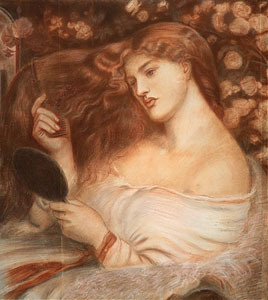Friday Tidbits!
 One . . . two . . .
One . . . two . . . Here is an interesting little writing rule that isn't commonly talked about, but which is actually far more important than you might realize.
It's called the Rule of Three.
It's a rule that is commonly used in the visual arts. Trained artists know that an arrangement of three major focal points is more pleasing to the eye. Interior decorators will often arrange things in groups of three as well: two mirrors and a picture frame, or two photos and a clock.
In painting, you see this rule represented all over the place! Many Rennaissance paintings were arranged in triangular shapes, with the points of the triangle providing the three major focual points.
 This piece is actually painted a triangular surface, making it very easy for three focal points to dominate and lead the eye.
This piece is actually painted a triangular surface, making it very easy for three focal points to dominate and lead the eye. It's a little harder to spot in this painting . . . but can you see how her head, neck, shoulder, and right hand form a soft, triangular composition? Again, very pleasing to the eye. Okay, you say, so that's painting. How does that apply to fiction? Quite naturally! Have you ever heard of The Three Stooges? The Three Blind Mice? Three Little Pigs? Three Billygoats Gruff? Goldilocks and the Three Bears? How about the classic maiden and two ugly stepsisters? Or the even more classic, maiden, mother, and crone? The rule of three is everywhere in fiction! Look at the most basic structure of a story: Beginning, Middle, and End. There's a three for you all over again. For some reason things that come in sets of three are more satisfying, funnier, more effective than other numbers. The same is true when it comes to plotting. Let me use an example from a recent rough draft of my own. In an early chapter, I had the main character recall a lullaby his mother used to sing to him. Now this lullaby contained one of the most important themes in the story, and I planned to end the narrative by repeating the lullaby on the last page. But, especially for something as important as the very end, you can't introduce a theme and then drop it until the last page. That's where the Rule of Three becomes important. I had find at least one more place within the story to reference or even quote that lullaby. This creates a sense of pattern that is pleasing to the readerly eye, without feeling repetitious. The Rule of Three. Now this instance was a short story. In a longer novel, you can find ways to effectively repeat and reemphasize themes more than three times. But, if you introduce and important theme, you want to bring it back at least three times. Once--it's not a theme. Twice--it's coincidence. Three times--it's a theme, and the reader files it away as important. Does this make sense to you? How might you have used the Rule of Three in your own creative work?
It's a little harder to spot in this painting . . . but can you see how her head, neck, shoulder, and right hand form a soft, triangular composition? Again, very pleasing to the eye. Okay, you say, so that's painting. How does that apply to fiction? Quite naturally! Have you ever heard of The Three Stooges? The Three Blind Mice? Three Little Pigs? Three Billygoats Gruff? Goldilocks and the Three Bears? How about the classic maiden and two ugly stepsisters? Or the even more classic, maiden, mother, and crone? The rule of three is everywhere in fiction! Look at the most basic structure of a story: Beginning, Middle, and End. There's a three for you all over again. For some reason things that come in sets of three are more satisfying, funnier, more effective than other numbers. The same is true when it comes to plotting. Let me use an example from a recent rough draft of my own. In an early chapter, I had the main character recall a lullaby his mother used to sing to him. Now this lullaby contained one of the most important themes in the story, and I planned to end the narrative by repeating the lullaby on the last page. But, especially for something as important as the very end, you can't introduce a theme and then drop it until the last page. That's where the Rule of Three becomes important. I had find at least one more place within the story to reference or even quote that lullaby. This creates a sense of pattern that is pleasing to the readerly eye, without feeling repetitious. The Rule of Three. Now this instance was a short story. In a longer novel, you can find ways to effectively repeat and reemphasize themes more than three times. But, if you introduce and important theme, you want to bring it back at least three times. Once--it's not a theme. Twice--it's coincidence. Three times--it's a theme, and the reader files it away as important. Does this make sense to you? How might you have used the Rule of Three in your own creative work?
Published on March 01, 2013 09:28
No comments have been added yet.



